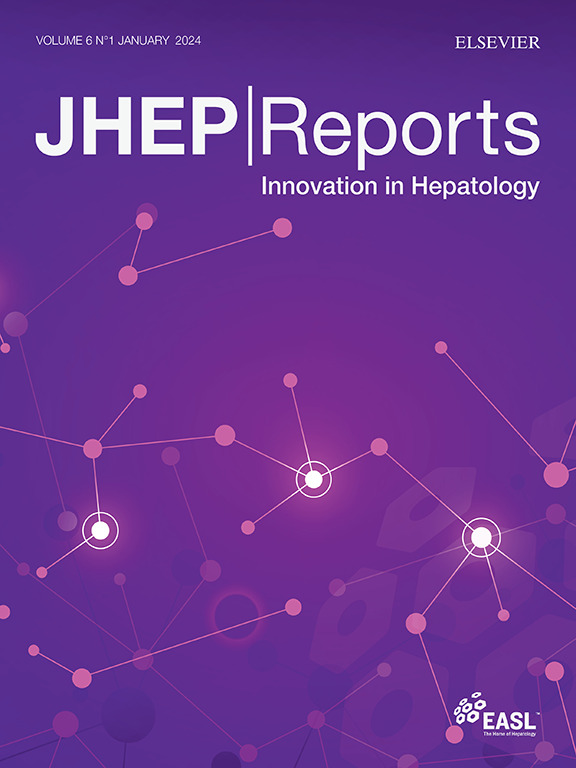Effect of liver biopsy size on MASLD fibrosis assessment by second-harmonic generation/two-photon excitation fluorescence microscopy
IF 7.5
1区 医学
Q1 GASTROENTEROLOGY & HEPATOLOGY
引用次数: 0
Abstract
Background & Aims
Fibrosis in metabolic dysfunction-associated steatotic liver disease (MASLD) is a prognostic indicator and clinical trial efficacy endpoint. Second-harmonic generation/two-photon excitation fluorescence (SHG/TPEF) microscopy images unstained tissue sections and, when integrated with artificial intelligence models, generates a continuous fibrosis value (qFibrosis) and ordinal qFibrosis stage. The impact of biopsy size and location on the accuracy of these approaches has not been assessed in MASLD, leaving quality assurance procedures undefined.
Methods
One unstained section each from 100 hepatectomy/explant MASLD cases, 20 of each pathologist-assigned Non-alcoholic Steatohepatitis Clinical Research Network (NASH-CRN) fibrosis stage (F0–F4), were used to create virtual core biopsies by cropping regions from within the whole parent section. Regions varied in length (5–30 mm) with a fixed width of 0.9 mm, width (0.5–1.3 mm) with a fixed length of 15 mm, or position within the whole parent section. SHG/TPEF was used, and the qFibrosis continuous value and stage of the virtual core biopsies were determined for comparison with those of the whole parent section.
Results
The qFibrosis continuous value and stage correlated strongly with pathologist-assigned NASH-CRN stage (rs = 0.92). Increasing the length and width of virtual biopsies increased the correlation between the qFibrosis continuous value and the agreement with the qFibrosis stage of the whole parent section, stabilising between 20–26 mm in length and 0.9 mm in width. The position within the tissue did not influence qFibrosis metrics.
Conclusions
Longer (>20 mm) and wider (>0.9 mm) biopsies provide more accurate fibrosis assessment using SHG/TPEF. Biopsy position and orientation do not influence accuracy.
Impact and implications
Fibrosis assessment is an important prognostic indicator and clinical trial endpoint in metabolic dysfunction-associated steatotic liver disease, but liver biopsy sampling variation quality assurance has not been investigated for second-harmonic generation/two-photon excitation fluorescence (SHG/TPEF) microscopy quantification of fibrosis. Longer (>20 mm) and wider (>0.9 mm) biopsies allow for more accurate digital assessment of fibrosis. Clinical trials should incorporate suitable protocols to verify biopsy sizes that optimise digital fibrosis assessment using SHG/TPEF.

肝活检大小对二次谐波/双光子激发荧光显微镜评估MASLD纤维化的影响
背景,目的:代谢功能障碍相关脂肪变性肝病(MASLD)的纤维化是一个预后指标和临床试验疗效终点。二次谐波生成/双光子激发荧光(SHG/TPEF)显微镜成像未染色的组织切片,当与人工智能模型结合时,产生连续纤维化值(qFibrosis)和顺序qFibrosis阶段。在MASLD中尚未评估活检大小和位置对这些方法准确性的影响,使得质量保证程序未定义。方法100例肝切除术/外植体MASLD患者各1张未染色切片,病理指定的非酒精性脂肪性肝炎临床研究网络(NASH-CRN)纤维化阶段(F0-F4)各20张切片,通过从整个母切片中裁剪区域来创建虚拟核心活检。区域的长度(5 - 30mm)不同,固定宽度为0.9 mm,宽度(0.5-1.3 mm)固定长度为15mm,或者位于整个母断面内。采用SHG/TPEF,确定虚拟核心活检的q纤维化连续值和分期,并与全母切片进行比较。结果qFibrosis的连续值和分期与病理NASH-CRN分期呈正相关(rs = 0.92)。增加虚拟活检的长度和宽度增加了q纤维化连续值与整个亲本切片的q纤维化阶段之间的相关性,稳定在长度20-26 mm和宽度0.9 mm之间。组织内的位置不影响q纤维化指标。结论更长(20mm)和更宽(0.9 mm)的活检可提供更准确的SHG/TPEF纤维化评估。活检的位置和方向不影响准确性。影响和意义纤维化评估是代谢功能障碍相关脂肪变性肝病的重要预后指标和临床试验终点,但肝活检取样变化质量保证尚未研究用于二次谐波产生/双光子激发荧光(SHG/TPEF)显微镜定量纤维化。更长的(20毫米)和更宽的(0.9毫米)活检可以更准确地对纤维化进行数字评估。临床试验应纳入合适的方案来验证活检大小,以优化使用SHG/TPEF进行数字化纤维化评估。
本文章由计算机程序翻译,如有差异,请以英文原文为准。
求助全文
约1分钟内获得全文
求助全文
来源期刊

JHEP Reports
GASTROENTEROLOGY & HEPATOLOGY-
CiteScore
12.40
自引率
2.40%
发文量
161
审稿时长
36 days
期刊介绍:
JHEP Reports is an open access journal that is affiliated with the European Association for the Study of the Liver (EASL). It serves as a companion journal to the highly respected Journal of Hepatology.
The primary objective of JHEP Reports is to publish original papers and reviews that contribute to the advancement of knowledge in the field of liver diseases. The journal covers a wide range of topics, including basic, translational, and clinical research. It also focuses on global issues in hepatology, with particular emphasis on areas such as clinical trials, novel diagnostics, precision medicine and therapeutics, cancer research, cellular and molecular studies, artificial intelligence, microbiome research, epidemiology, and cutting-edge technologies.
In summary, JHEP Reports is dedicated to promoting scientific discoveries and innovations in liver diseases through the publication of high-quality research papers and reviews covering various aspects of hepatology.
 求助内容:
求助内容: 应助结果提醒方式:
应助结果提醒方式:


